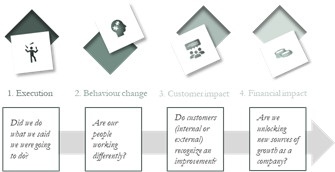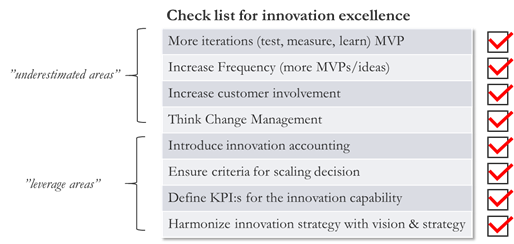Innovation is becoming a business critical capability in industries around the globe. We can see this on the disruption which affects all industries, the competition from fast-moving and well capitalized start-ups, and in increased R&D and innovation budgets in established companies.
Swedish companies hold a historically strong position within innovation internationally.
We were curious about the current state of the Swedish companies. What are the keys to the Swedish innovation wonder and what issues are they struggling with to turn innovation into business value?
We believed there is knowledge and best practice across industries that combined would give us the best picture, why we initiated the study “Innovation as a growth engine” with representation from different industries and different innovation backgrounds. The companies in our study have a life span ranging from 2 – 732 years and represents retail, venture capital, manufacturing and tech. Among the interviewed companies you find Stora Enso, Volvo Car Mobility, Telia Company and Monki.
12 deep interviews were conducted with people representing different roles such as Head of Business Innovation, CTO, Head of Innovation Lab, Head of Growth, Head of Strategic Innovation, and CEO. All with responsibility for innovation and growth.
We asked them questions around expectations on innovation from top management, customer involvement, innovation governance, business Integration, scalability and business value.
The summary of the study will be discussed in a blog series of two parts. This is the second part, where we’ll share our observation of the innovation process, the budgeting, about governance model, and our recommendations.
In the first part, we gave an overview of the state of innovation in Swedish companies, where in the organisation you find innovation and the nest step for the innovation practice. 
The Innovation process
Overall, there is large potential in formalising the innovation process. We have zoomed in on the four key activities Idea generation, Experiment & test, Scaling decisions and Scaling up in the innovation process. We observed that the challenges are greater in the later steps in this process. This is remarkable since the costs often are higher for the activities later in the process.

Below we will share examples of successful approaches as well as improvement areas for each of the key activities.
Idea generation
 Successful approach
Successful approach
· The boundaries between different business verticals are reducing in today’s environment. You cannot anymore ensure you are excelling only in your own business verticals. The speed for start-ups to scale, for new business models to disrupt markets, and for new technology to define new market rules are increasing significantly. Therefore, the industry boundaries are becoming less important. To ensure competing on the larger arena companies need to work with trends in a systematic way across perspectives. By working with perspectives such as product technology, surrounding technology, industry trends and business trends help the organisation to ensure opening up the funnel to be competitive for tomorrows market.
 Improvement area
Improvement area
· An issue that many struggles with this phase is to generate the right ideas. To manage this, you need to generate many relevant ideas to filter amongst, and the right decision criteria that not only favour the low-risk ones. Most companies don’t get sufficient amount of ideas, which limit the quality of the coming steps.
Experiment & test
 Successful approach
Successful approach
· This phase is about developing and evaluating ideas as quick as possible through short iterations by understanding the value for customer. One company expressed that having a high frequency with many iterations of many ideas was their success formula.
 Improvement area
Improvement area
· An area that quite many companies struggled with was closing ideas and initiatives as much as necessary and as early as possible. Closing ideas is a key to be able to optimize the time and investments by selecting the right ones to develop further.
Scaling Decision
 Successful approach
Successful approach
· Management often expects business case as decision ground for scaling decisions since this is the common tool for business decisions in other areas. However, in many situations when understanding the potential of innovation initiatives business case is only one out of many measurements. One respondent in the study said they evaluate several other areas, whereas in what way the initiative is aligned with the strategic direction is one such. The same respondent agreed to not overemphasizing the financial part and expressed the following:
o “It’s not possible to make a BC in such early phase, it is too much uncertainties. I told them: What numbers do you want me to include in the BC? “
 Improvement area
Improvement area
· Extensive potential exists in making scaling decisions based on portfolio thinking and relevant evaluation criteria depending on innovation horizon. To have the right decision criteria in place results not only that good ideas are developed, but also that it is easier to select the high risk – high reward ideas, and gives an all-in mentality for the ideas that get chosen. Two potential areas that are of great important is that you apply portfolio method, and ensure the measurement is customized for different phases. One method that that supports rational scaling decisions is Innovation Accounting.
Scaling up
 Successful approach
Successful approach
· We found it rare to have a solid process for scaling up. To compensate this and enable scaling up, a proven approach is to involve stakeholders in the early phases to been able to scale at a later stage.
 Improvement area
Improvement area
· There is a potential overall to structure the scale up process and make it less dependent on individuals. The innovation process must be companywide and not only located to for instance the product development practice. This include establishing clear scaling decision criteria included ensuring strategy alignment.
Budgeting
Budgeting for the early phases in the process, such as the idea generation step, for most of the cases relatively clear and decent funded.
However, the budget allocation is not clear for the scaling up activities for most of the companies, except a few companies of the archetypes “R&D heritages” or “No Legacy” defined in the first blog. 
For others, the budget is decided case by case in a more ad hoc manner. One consequence of this is that it discourages the high risk – high rewards ideas.
The next steps for this area are to start applying and implementing metered funding. Metered funding is a way to control budget and promote the initiatives that prove potential. The way this works is that you have smaller budget for respective initiative, and then you add incrementally budget if the initiative is growing and is demonstrating progress. The budgeting process is aligned with the iterative way of working. This also means that you close initiatives more frequent, and thereby free up budget which enable more precise spending on the things that creates most value.

The Innovation Governance
In the first blog we wrote that the maturity of the innovation practice is relatively low. This can also be reflected in the governance. Majorly, there are two different metrics that are of interest; Evaluating success of the innovation practice, and Evaluating project success.
Evaluating success of the innovation practice
Many companies in the study are in the progress of defining these types of measurements. It can be milestones such as established innovation process, or more specific establish collaboration with external partners.
Our analysis of the innovation practice is clear. The choice of measurements should be reflected by the change journey and where you are with your practice. We normally use Eric Reiss, author to Lean Startup, framework for defined this key change phases.

Evaluating project success
The maturity of evaluating project success differ widely between the interviewed organisations. Examples of used metrics are Number of initiatives developed with customers, and expected ROI (which is a hard to estimate in early phases)
We see a huge potential for applying innovation accounting when evaluating experiments and for scaling up decisions. It means measurements focusing on customer value and growth potential. It is for instance fundamental to understand if the customer’s willingness to pay, and how much. And what can be adjusted in the product / service further that’ll make them be willing to pay more?
Recommendation
Generally speaking, to move from informal practice to key practice for business success its about
· Building on what you have and leverage your legacy by adding success factors from other industries and companies.
· Continuing encourage collaboration between people, competencies and departments, this is where innovation always happen.
· Unburden individuals and innovation labs through introducing a systematic approach. But don’t take away the fun part. It’s all about balance between many polarities, and this is one.

More specifically, and to get started quickly, take on some of the points form our checklist below.
Do you want to discuss you company’s situation and next steps for the innovation practice, don’t hesitate contact us.
Ulrika Bernhoff - Partner & advisor within strategy, innovation and organisation
Johan Andersson - Client Director & advisor within strategy, strategy execution and organisation

